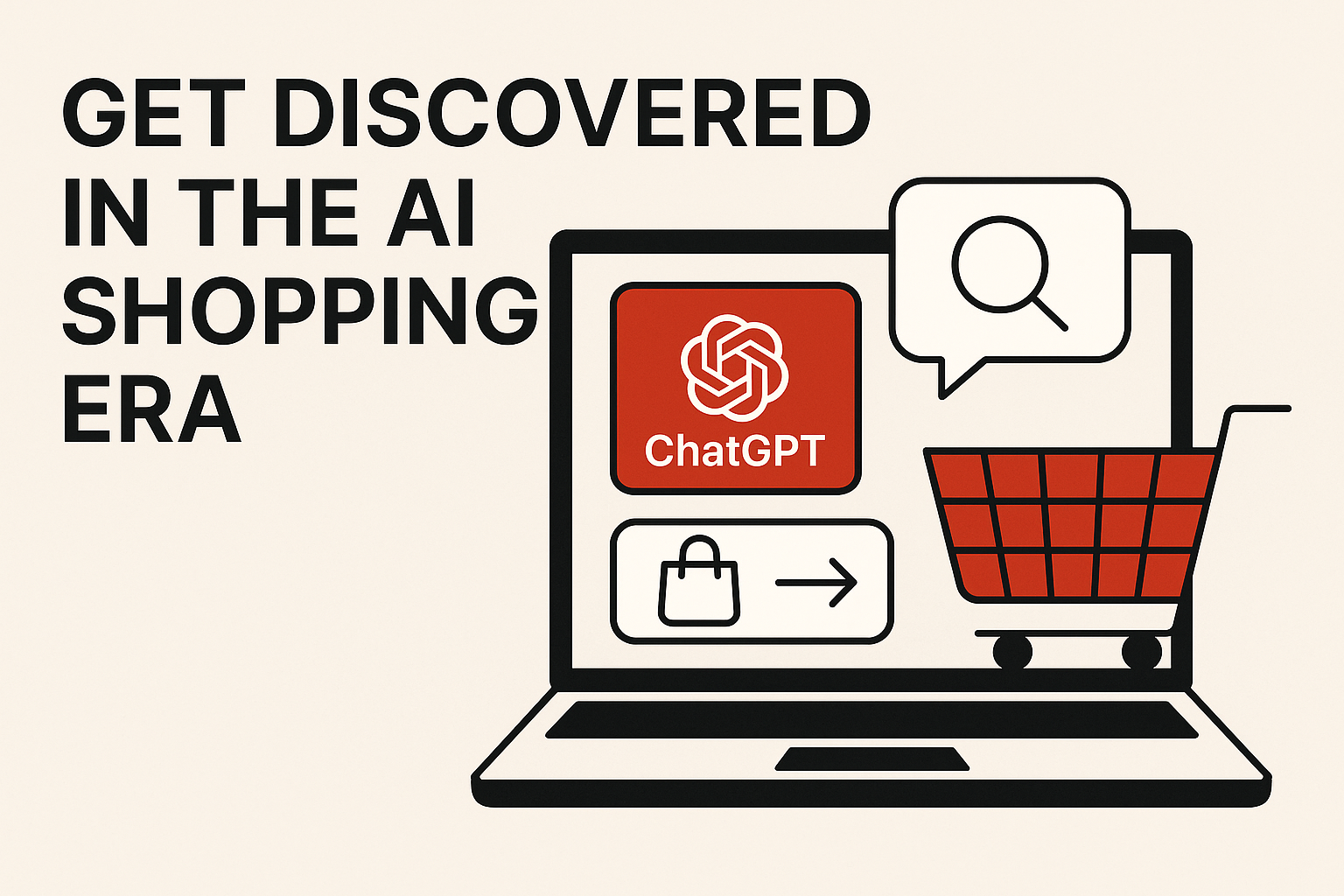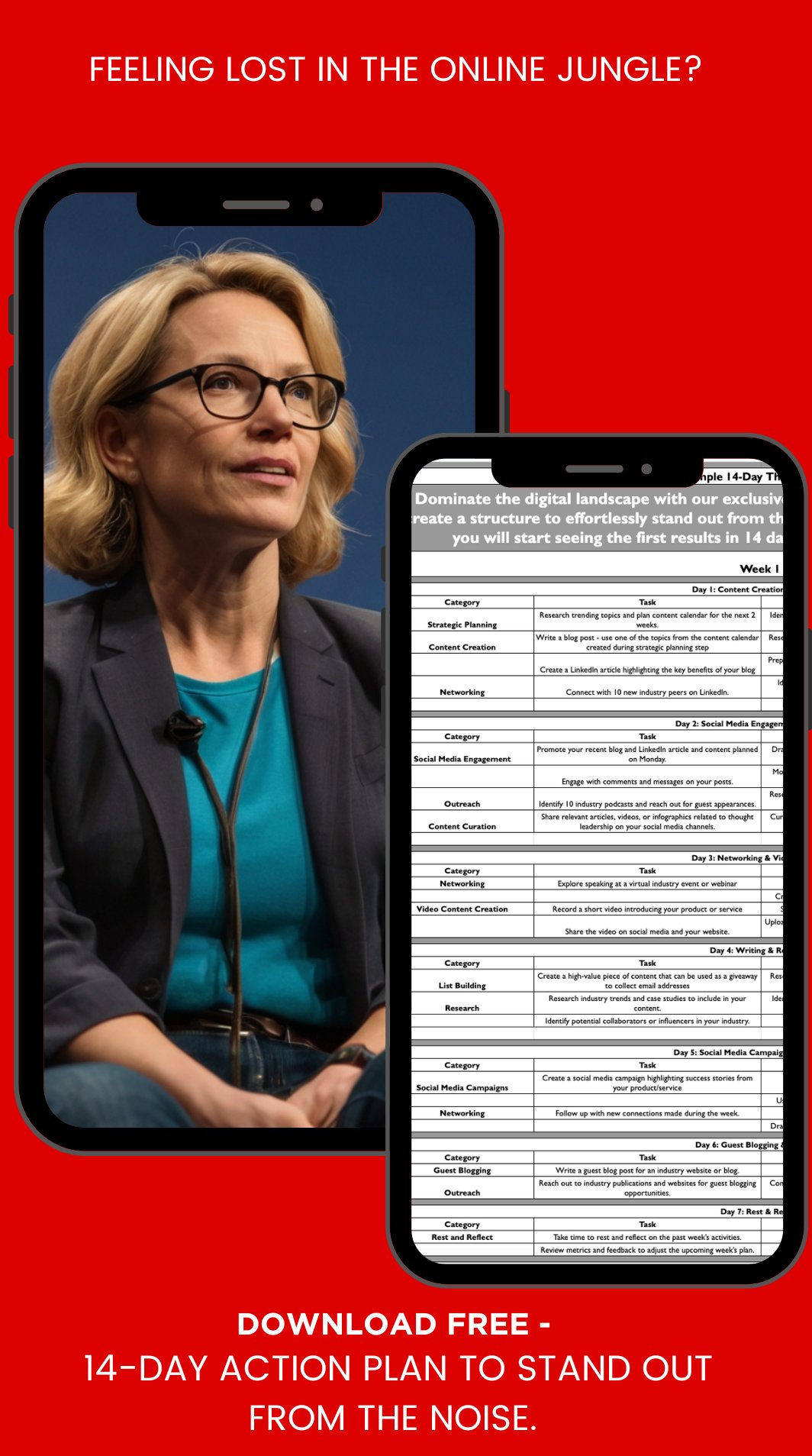“$50,000 spent on Meta ads last quarter. 2,147 leads generated. Sounds great, right? Except only 13 turned into actual customers.”
This confession from a fellow tech CEO during a recent growth workshop made the room go quiet.
Not because the numbers were shocking, but because everyone recognized their own story in those figures.
I see it time and time again: sophisticated tech companies with cutting-edge products running Meta ad campaigns like they’re still in 2015.
The dashboards show green arrows pointing up, but the bank account tells a different story.
Last month, we audited Meta ad accounts for 10 high-growth tech companies.
The pattern was startling:
82% were hitting their lead generation targets, but only 16% were achieving their customer acquisition goals.
The rest were stuck in what I call the “vanity metrics trap” – optimizing for clicks and leads while bleeding cash on the path to actual revenue.
One CEO was spending $30,000 monthly on ads that targeted “technology decision-makers.”
Sounds logical, right?
But when we dug deeper, we discovered his best-performing campaigns weren’t reaching CTOs at all – they were connecting with frustrated middle managers who had the exact pain point his product solved.
Here’s what most agencies won’t tell you: Meta’s algorithm is incredibly powerful, but it’s also dangerously good at finding the wrong kind of “right” audience.
It’s like having a brilliant employee who’s excellent at completing the wrong tasks.
The difference between burning cash and building a predictable growth engine isn’t in doubling your ad budget or testing fifty new creatives.
It’s in understanding the hidden levers that turn Meta’s vast targeting ecosystem into your personal lead-generation machine.
Let me show you exactly how to audit your Meta campaigns like a growth strategist – and finally bridge the gap between flashy metrics and real revenue…
Table of Contents
ToggleWhy You Need to Audit Your Meta Ad Campaigns
Scaling a startup is akin to building a rocket — every part must be in perfect sync.
In the same way, digital marketing has to be tightly aligned with your business goals to propel you forward.
But what happens when your campaigns are not firing on all cylinders?
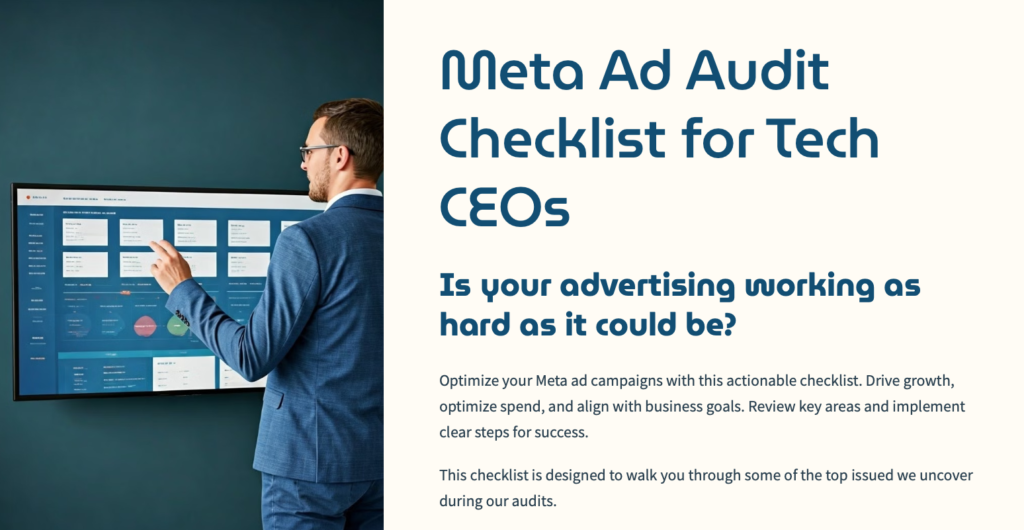
A thorough audit of your Meta ad campaigns helps to:
- Identify wasted spend and optimize your budget.
- Improve targeting by refining audience segmentation and exclusions.
- Boost creative effectiveness through better A/B testing.
- Increase scalability by pinpointing what’s working and doubling down.
Let’s break this down step by step, just like you’d want to assess the performance of your engineering team, financial models, or product roadmap.
1. Ad Account Structure: The Foundation of Success
Your ad account is the backbone of your digital marketing efforts. How well-structured is it?
- How many ad accounts do you have? If you’re managing multiple accounts, the complexity can easily become overwhelming, leading to mismanaged budgets or disjointed campaigns.
- How old is the account? Older accounts provide a treasure trove of data, but often, legacy strategies may not be aligned with your current business objectives. An account that started with a focus on lead generation, for instance, might need to pivot towards conversions or sales.
- Platform Diversity: Are you targeting just Facebook, or are you also hitting Instagram, Audience Network, and Messenger? Spreading campaigns across platforms can diversify reach, but it also complicates reporting and optimization.
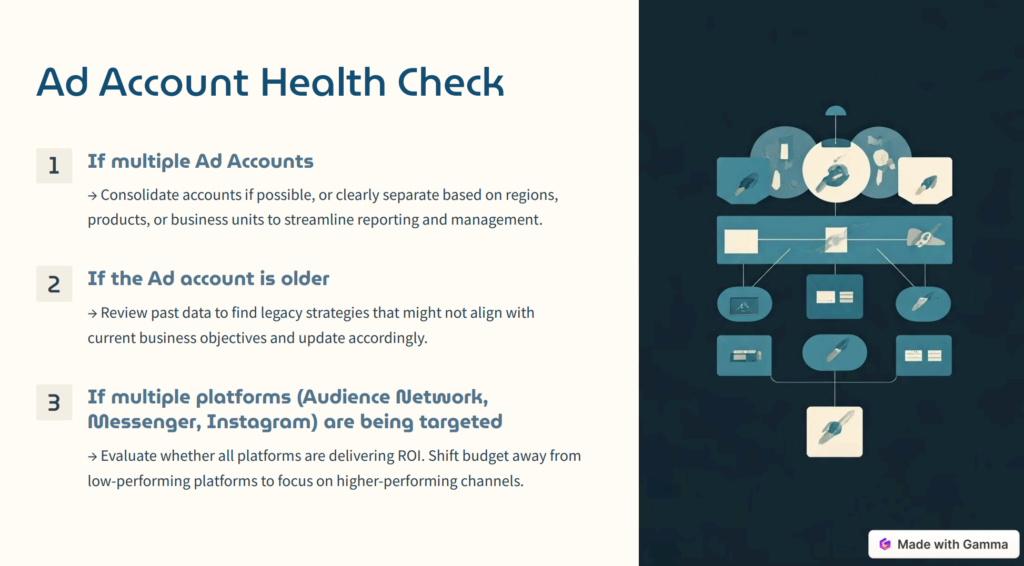
- Check: How many ad accounts are there?
- If multiple accounts → Consolidate accounts if possible, or clearly separate based on regions, products, or business units to streamline reporting and management.
- Check: How old is the Facebook ad account?
- If the account is older → Review past data to find legacy strategies that might not align with current business objectives and update accordingly.
- Check: What platforms are targeted (Facebook, Instagram, Audience Network, Messenger)?
- If all platforms are being targeted → Evaluate whether all platforms are delivering ROI. Shift budget away from low-performing platforms to focus on higher-performing channels.
Pro Tip: If you’re managing a larger ad account, think of it like managing a fleet of cloud servers—if one is underperforming, it drags the rest down. The same goes for Meta ad accounts; a disjointed structure can undercut the performance of your highest ROI channels.
2. Campaign Strategy and Structure: Optimizing for Growth
Effective ad campaigns are a strategic mix of goals, budgets, and audience segmentation. Each of these factors can make or break your growth trajectory.
- How many campaigns are active and historical? If your campaigns are cluttered with past efforts, it’s akin to having too much technical debt in your product code—time for some refactoring.
- Audience Segmentation: Are you hyper-targeted with segmented audiences, or are your campaigns too broad? Poor audience segmentation can result in wasted ad spend. If your targeting isn’t precise, your message won’t resonate, much like how a poorly targeted product feature misses user needs.
- Budget Allocation: Are you allocating budgets effectively between campaigns? Much like prioritizing resources for product features, your ad campaigns need smart budgeting based on performance.
- Bidding Strategy: Whether you use manual or automatic bidding will affect the level of control you have over costs. Automatic bidding may save time but sacrifices precision, while manual bidding can lead to cost-efficiency but requires constant monitoring.
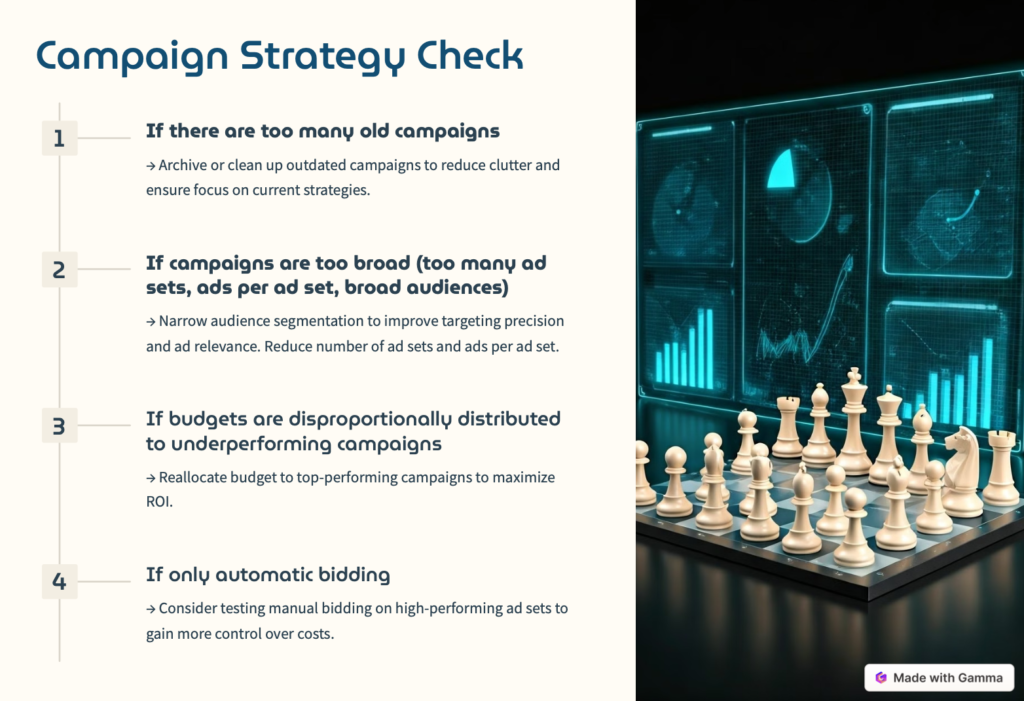
- Check: How many active and past campaigns are there?
- If there are too many old campaigns → Archive or clean up outdated campaigns to reduce clutter and ensure focus on current strategies.
- Check: What is the structure of your campaigns (e.g., number of ad sets, audience segmentation)?
- If campaigns are too broad → Narrow audience segmentation to improve targeting precision and ad relevance.
- Check: How are budget allocations distributed across campaigns?
- If one campaign underperforms → Reallocate budget to top-performing campaigns to maximize ROI.
- Check: What bidding strategies are being used (manual vs. automatic)?
- If only automatic bidding → Consider testing manual bidding on high-performing ad sets to gain more control over costs.
Pro Tip: Similar to optimizing your cloud infrastructure for cost and performance, budget allocation across your campaigns should focus on efficiency. Optimize for the highest ROI, but don’t hesitate to scale campaigns that are truly working.
3. Audience Targeting: Maximizing Relevance
Your ad campaigns are only as good as the audience you target. Inaccurate targeting results in wasted spend and missed opportunities.
- Custom and Lookalike Audiences: Are you tapping into the full potential of custom audiences (e.g., past website visitors or app users) and lookalike audiences? These groups often perform better than broader interest-based audiences due to higher relevance.
- Remarketing Strategy: How are you engaging with users who already showed interest? Remarketing campaigns are crucial, yet they often get neglected. It’s like ignoring repeat customers in your SaaS business — a missed opportunity for low-cost conversions.
- Exclusion Lists: Are you excluding audiences that don’t add value (e.g., users who already converted or competitors)? Just as you wouldn’t want your product development team wasting time on deprecated features, make sure your campaigns aren’t burning money on irrelevant audiences.
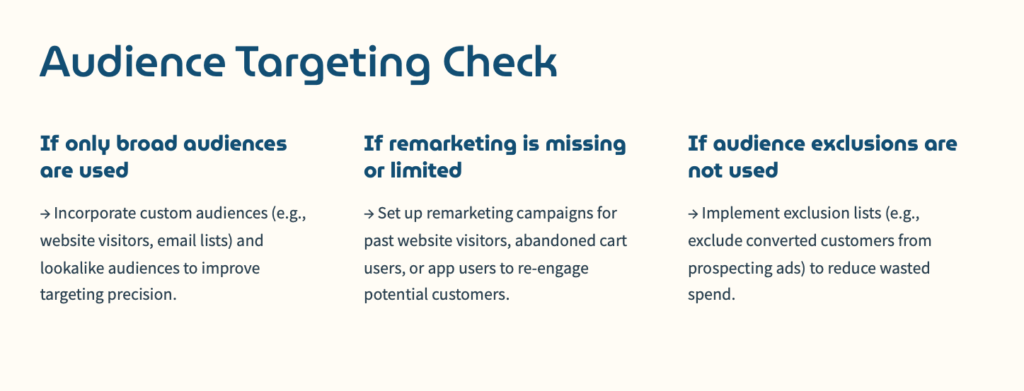
- Check: What audience types are targeted (custom audiences, lookalike audiences, interests)?
- If only broad audiences are used → Incorporate custom audiences (e.g., website visitors, email lists) and lookalike audiences to improve targeting precision.
- Check: How is the remarketing set up?
- If remarketing is missing or limited → Set up remarketing campaigns for past website visitors, abandoned cart users, or app users to re-engage potential customers.
- Check: What audience exclusions are in place to avoid overlap or redundancy?
- If exclusions are not used → Implement exclusion lists (e.g., exclude converted customers from prospecting ads) to reduce wasted spend.
Pro Tip: If your audience targeting feels off, it’s like building the wrong feature set for your users. Use data from your CRM or sales funnel to inform audience targeting—no guesswork needed.
4. Ad Creative: The Art and Science of Persuasion
Creative is the heart of your campaigns. The quality of your ad copy, images, and videos significantly impacts performance.
- Creative Refresh: How often are you updating your creatives? Stale creatives lead to ad fatigue. Think of it like rolling out updates for your SaaS product; you wouldn’t keep the same version running without improvements for months.
- Types of Creatives: Are you using a mix of formats (video, images, carousels)? Some users respond better to videos, while others prefer carousel ads that allow for multiple pieces of information. Don’t limit yourself to one format.
- A/B Testing: Are you actively split testing different creatives? Just like A/B testing your product’s UX/UI, you should experiment with various creative options to see what resonates best with your audience.
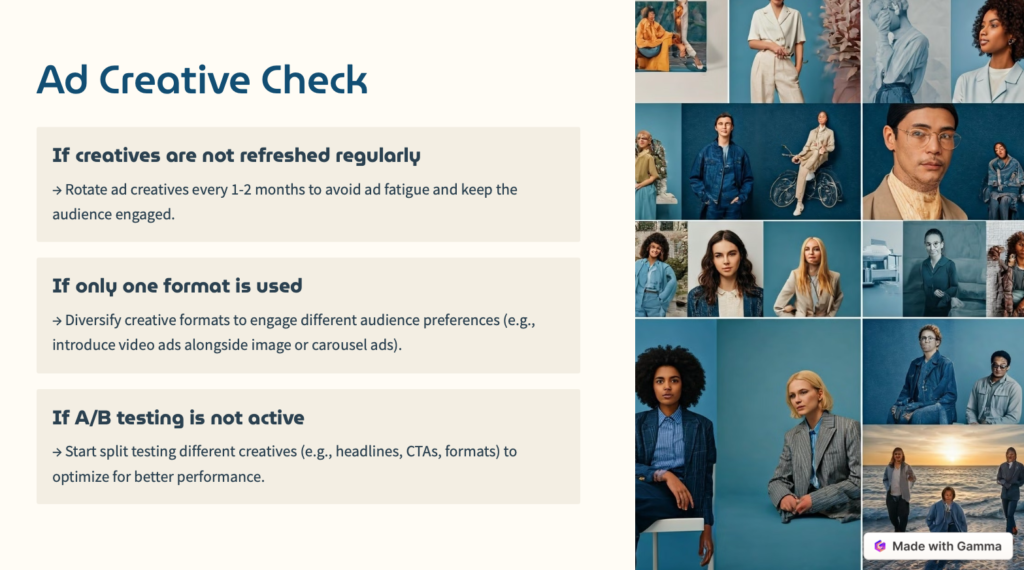
- Check: How many ad creatives are running, and how often are they refreshed?
- If creatives are not refreshed regularly → Rotate ad creatives every 1-2 months to avoid ad fatigue and keep the audience engaged.
- Check: What types of creatives are being used (videos, images, carousels)?
- If only one format is used → Diversify creative formats to engage different audience preferences (e.g., introduce video ads alongside image or carousel ads).
- Check: Are variations for A/B testing being used?
- If A/B testing is not active → Start split testing different creatives (e.g., headlines, CTAs, formats) to optimize for better performance.
Pro Tip: Use A/B testing to gather actionable data, then iterate. Much like how you optimize your MVP, continually refining your creative assets will lead to better performance over time.
5. Performance and KPIs: The Truth Is in the Numbers
Performance metrics give you the raw data to measure the success of your campaigns, but numbers need context.
- Key KPIs: Are you tracking the right metrics like CTR (click-through rate), CPA (cost per acquisition), ROAS (return on ad spend), and conversion rates? Much like tracking the financial health of your company, KPIs help you gauge how well your campaigns are moving the needle.
- Historical Trends: Are there any trends in performance over time? Have certain periods shown spikes or drops? Analyzing these trends can help you diagnose issues or find opportunities for growth.
- Cross-Platform Discrepancies: Do the numbers in Facebook Ads Manager match what you’re seeing in Google Analytics or Shopify? If not, there may be tracking or attribution issues. Much like integrating your SaaS platform with third-party tools, consistency in data is crucial for making informed decisions.
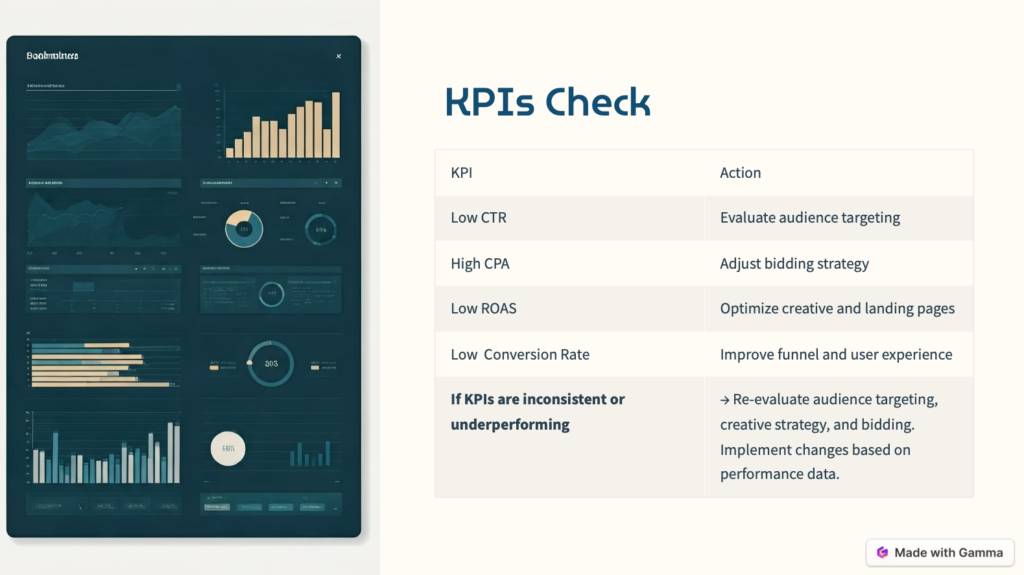
- Check: What are the main KPIs being tracked (CTR, CPA, ROAS, conversion rate)?
- If KPIs are inconsistent or underperforming → Re-evaluate audience targeting, creative strategy, and bidding. Implement changes based on performance data.
- Check: What are the historical trends in performance?
- If performance has declined → Investigate potential causes (e.g., ad fatigue, poor audience targeting) and adjust campaigns accordingly.
- Check: How is tracking set up (Facebook Pixel, Conversions API)?
- If tracking isn’t properly implemented → Ensure Facebook Pixel and Conversions API are correctly set up to capture valuable user data and optimize campaigns.
- Check: Are there discrepancies between Ads Manager and other platforms (e.g., Google Analytics, Shopify)?
- If discrepancies exist → Investigate attribution models and cross-platform tracking to align reporting and understand where conversions are coming from.
Pro Tip: It’s not just about looking at raw numbers but understanding the story they tell. A drop in CTR might signal ad fatigue, while a lower ROAS could indicate poor targeting or budget allocation.
6. Budget Management and Scaling: Fueling Future Growth
One of the most critical aspects of managing Meta ad campaigns is ensuring that your ad spend is aligned with your growth goals.
- Monthly Ad Spend: Are you spending enough to make a significant impact but not so much that you’re seeing diminishing returns? Like managing burn rate in a startup, you need to strike the right balance between aggressive investment and sustainable growth.
- Scaling Process: How do you adjust your budgets and scale successful campaigns? Is it an ad-hoc process, or is there a system in place for scaling? Growth requires a calculated, data-driven approach, just like scaling your business from a lean startup to a larger enterprise.
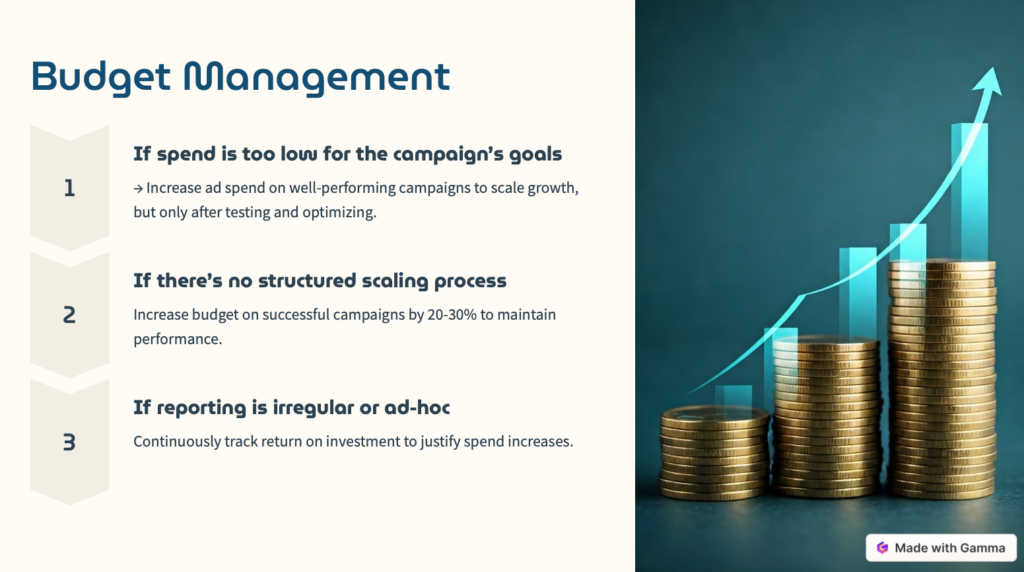
- Check: What is the overall monthly ad spend?
- If spend is too low for the campaign’s goals → Increase ad spend on well-performing campaigns to scale growth, but only after testing and optimizing.
- Check: How often is the budget adjusted, and how are successful campaigns scaled?
- If there’s no structured scaling process → Implement a clear process for scaling winning campaigns, gradually increasing budget by 20-30% to avoid disrupting performance
Pro Tip: Scaling successful ad campaigns is like scaling product adoption—only increase investment once you’ve proven the model works and have the infrastructure to support it.
7. Reporting and Analytics: Staying Data-Driven
Finally, a critical piece of auditing your Meta ads is how well you’re reporting on and analyzing performance.
- Frequency of Reports: How often are performance reports generated (weekly, monthly)? Consistent reporting helps you stay on top of issues before they become bigger problems.
- Manual vs. Automated Reporting: Are you still generating reports manually, or are you leveraging automated tools? Manual reporting is time-consuming, akin to manually tracking user behavior on your platform when you could be using automated analytics software.
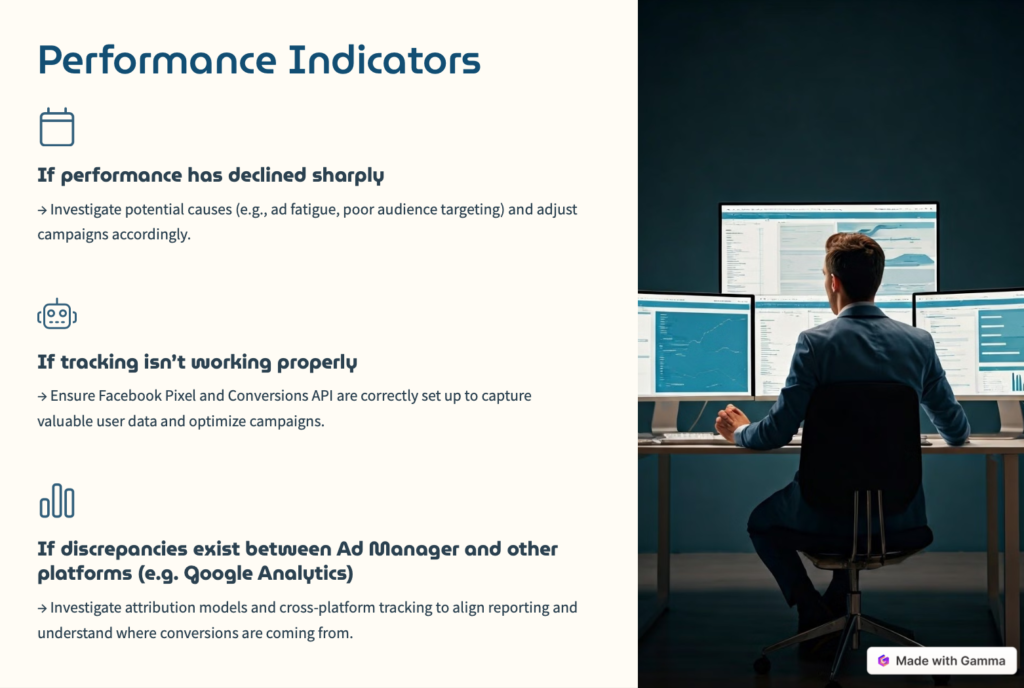
- Check: How is performance reported (weekly, monthly)?
- If reporting is irregular or ad-hoc → Establish a consistent reporting schedule (weekly or monthly) to track performance and pivot strategies when necessary.
- Check: What tools are used for reporting (manual vs. automated)?
- If reports are generated manually → Automate reporting through tools like Google Data Studio or Supermetrics to save time and ensure data accuracy.
Pro Tip: Set up automated reports that give you real-time insights, so you can pivot quickly if needed—just like how your product team would respond to a sudden influx of user feedback.
8. Compliance and Policy
Frequent ad rejections or negative user feedback can impact your campaign performance
- Check: Have there been any ad rejections or account issues due to policy violations?
- If ads are frequently rejected → Review Facebook’s advertising policies to ensure compliance and prevent ad rejections that can hurt campaign momentum.
- Check: Are there any issues with audience feedback (e.g., negative comments, poor relevance scores)?
- If relevance scores are low or feedback is negative → Review ad creative and messaging to ensure it aligns with audience expectations and isn’t causing frustration.
Conclusion: Elevate Your Meta Ads for Scalable Growth
By conducting a thorough audit of your Meta ad campaigns, you’ll uncover inefficiencies, optimize performance, and align your digital marketing efforts with your broader business goals. Just as you would review your codebase, product strategy, or team performance, an ad audit provides critical insights that drive improvement.
Takeaways:
- Ensure your ad account structure aligns with your current business goals.
- Optimize campaign strategy and audience targeting for maximum impact.
- Continuously refresh your ad creatives and A/B test for better results.
- Focus on key performance metrics and address any cross-platform discrepancies.
- Scale efficiently by monitoring budget allocation and increasing investment in successful campaigns.
Forward-Looking Thought:
Think of your Meta ad campaigns as another growth engine in your tech startup. When fine-tuned, they can accelerate your business trajectory, driving more customers, increasing brand awareness, and fueling your company’s long-term success. But to truly unlock their potential, you need to approach ad campaigns with the same rigor and strategic thinking that you apply to your product development, engineering efforts, and financial planning.
Beyond the Audit: Continuous Improvement and Iteration
An audit is not a one-time task—it’s the foundation of an ongoing process of optimization and growth. As your business evolves, so will your ad strategies. The market changes, customer behaviors shift, and new advertising tools or features become available.
What’s Next?
- Regular Audits: Make audits part of your quarterly routine, just like reviewing financials or sprint retrospectives.
- Data-Driven Decisions: Use the insights from your audits to continuously refine your ad campaigns. Lean into what works, and cut what doesn’t.
- Innovate: Always be on the lookout for new ad formats, creative strategies, and targeting methods that can give you a competitive edge.
- Scale with Care: Scaling your ad spend is essential, but only once you’ve nailed down what works. As with scaling your business, ensure your foundation is strong before accelerating growth.
Final Thought: Start Treating Your Meta Ads Like an Integral Part of Your Growth Strategy
The biggest mistake many tech CEOs make is viewing their ad campaigns as separate from their core business strategy. In reality, your Meta ad efforts should be tightly integrated with your sales goals, product launches, and broader company vision. When you align these strategies, you’ll see not just better ad performance but tangible business results that contribute to your overall success.
Let this audit be the beginning of that alignment, and watch as your Meta ads become a true growth driver for your startup.
Let’s dive into the next stage of your company’s journey: sustainable, data-driven scaling.






